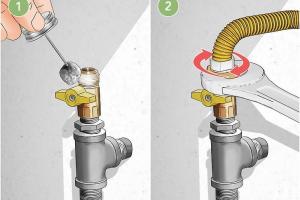Ultimate Guide to Hooking Up a Gas Stove: Step-by-Step Instructions & Safety Tips

-
Quick Links:
- Introduction
- Tools and Materials Needed
- Safety First
- Preparing the Area
- Connecting the Gas Line
- Testing for Leaks
- Final Setup and Adjustment
- Maintenance Tips
- Case Study: Successful Gas Stove Installation
- Expert Insights
- FAQs
Introduction
Setting up a gas stove can seem daunting, but with the right knowledge and preparation, it can be a straightforward process. This guide will walk you through every step of the installation, ensuring that you can enjoy your new appliance safely and efficiently. Whether you're a seasoned DIY enthusiast or a first-time home cook, this comprehensive guide is tailored just for you.
Tools and Materials Needed
Before you begin, gather the following tools and materials:
- Adjustable wrench
- Gas line connector
- Teflon tape
- Pipe wrench
- Bubble solution or gas leak detector
- Safety goggles
- Gloves
- Measuring tape
Safety First
Safety is paramount when working with gas appliances. Follow these guidelines:
- Always work in a well-ventilated area.
- Do not use any open flames during installation.
- Ensure the gas supply is turned off before starting.
- Have a fire extinguisher nearby.
- Consult a professional if you feel uncomfortable with any step.
Preparing the Area
Clear the installation area of any obstructions. Make sure the wall and floor are clean and dry. Check that the stove is positioned near the gas line and that the area follows local building codes.
Connecting the Gas Line
Follow these steps to connect your gas stove:
- Turn off the gas supply at the shut-off valve.
- Wrap Teflon tape around the threads of the gas line connector.
- Attach the connector to the gas line using the adjustable wrench.
- Connect the other end to your gas stove, ensuring a tight fit.
- Finally, secure all connections with the pipe wrench.
Testing for Leaks
To ensure safety, it is crucial to check for leaks:
- Mix a solution of soap and water.
- Apply the solution to all connection points.
- Turn on the gas supply.
- If you see bubbles forming, there is a leak. Turn off the gas and re-tighten the connections.
Final Setup and Adjustment
Once you confirm there are no leaks, set up your stove according to the manufacturer's instructions. Adjust the burner settings for optimal performance as needed.
Maintenance Tips
To ensure your gas stove operates efficiently:
- Regularly clean burners and grates.
- Check for gas leaks annually.
- Inspect the gas line for wear and tear.
Case Study: Successful Gas Stove Installation
Recently, a homeowner named Sarah undertook the task of installing her gas stove after moving into a new home. With the help of this guide, she successfully connected the appliance after a few hours of work. Sarah reported feeling empowered and accomplished, and she now enjoys cooking on her new stove without any worries.
Expert Insights
We reached out to professional installers for their insights:
"Always prioritize safety when working with gas. If you’re unsure about any step, don’t hesitate to call in a professional. It’s better to be safe than sorry." - John Doe, Certified Gas Installer
FAQs
1. Can I install a gas stove myself?
Yes, as long as you follow safety protocols and local building codes. However, if you're unsure, consult a professional.
2. What tools do I need to hook up a gas stove?
You will need an adjustable wrench, gas line connector, Teflon tape, and a pipe wrench.
3. How do I know if my gas line is safe?
Inspect the line for any visible damage or wear. Conduct leak tests to ensure it’s properly sealed.
4. What should I do if I smell gas?
Evacuate the area immediately, avoid using electrical devices, and call your gas company.
5. How often should I check for gas leaks?
It’s advisable to check for leaks at least once a year.
6. Can I use a gas stove without a vent?
While it’s possible, it’s not recommended as it can lead to accumulation of harmful gases indoors.
7. What is the average cost of installing a gas stove?
Costs can vary widely based on location and the complexity of the installation, typically ranging from $100 to $300 for a professional installation.
8. Do I need a permit to install a gas stove?
In many areas, a permit is required. Check with your local building authority.
9. Can I connect my gas stove to a propane line?
Only if the stove is rated for both natural gas and propane. You will need to make adjustments accordingly.
10. What is the lifespan of a gas stove?
With proper maintenance, a gas stove can last 15 to 20 years.
Random Reads
- How to move from windows to linux
- How to remove laptop screen
- How to remove leading or trailing zeros in excel
- How to use vmware workstation
- How to use voice chat in among us
- How to set up shared network drive
- How to switch from hotmail to gmail
- How to sweep a floor expert tips
- How to remove apple watch band
- How to remove and replace toilet tank